Lately it seems that more and more people are abandoning inner tubes and jumping on the tubeless bandwagon. But are tubeless tires actually better? What advantages do they have and what are their disadvantages? In this article, you will find pretty much everything there is to know about tubeless bike tires, both the good and the bad.
What is a tubeless tire?
Most bike tires have an air-filled tube that sits under them. The pressure from this tube presses the tire beads against the rims and holds them in place. We all know about such bike tires with an inner tube, which are also known as clinchers. A tubeless tire gets rid of the tube. Wheels for tubeless tires are specially designed to have tighter tolerances. This provides an airtight seal between the rims and the tire beads. Tubeless tires were created to provide certain advantages. However, there are also some disadvantages that come with this design.
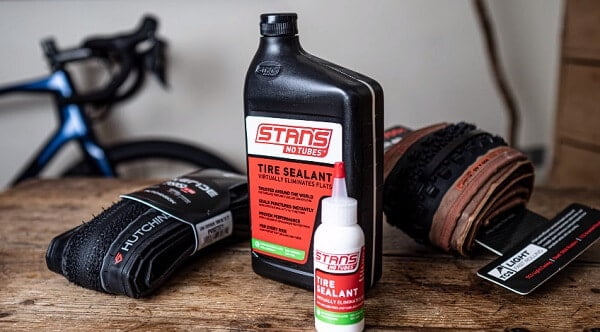
Tubeless Tire Pros
No pinch flats
A pinch flat occurs when you roll over a sharp edge to high speed and the inner tube gets ‘pinched’ against the rim. When this happens, the tube gets punctured, leaving behind a distinct mark called a ‘snake bite’ due to its appearance. Since there is no inner tube in a tubeless tire, this does not occur.
Fewer punctures
Tubeless tires are used with a liquid latex sealant which is poured into the tire through the air valve. If you get a small puncture, air pressure pushes the sealant towards the hole and particles in the sealant clog it up. This happens while you are still riding and sometimes you won’t even notice the puncture, so there’s no need to stop.
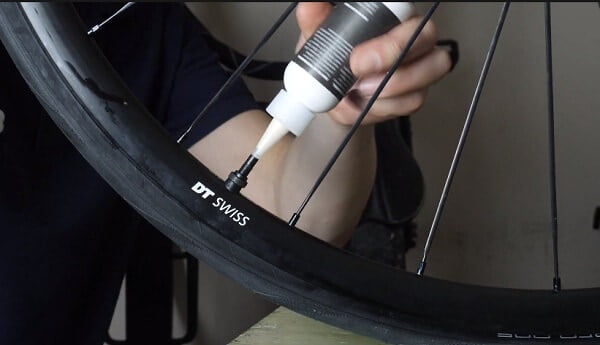
Lower tire pressures possible
When a tube is present, the tire needs to be at a relatively high pressure to protect the tube from pin flats. However, without a tube there is no need for that. A lower tire pressure creates a larger contact patch which provides better traction with the ground. Additionally, the tire can roll over objects with greater ease and absorb more of the impact. Therefore, your ride becomes more comfortable as well.
Less weight
The absence of an inner tube means there is one less component in the tire. You won’t be seeing a huge difference since the addition of sealant offsets some of the weight savings. But in some cases you can save upto 150 grams per wheel. This translates to an even greater weight reduction in terms of rotating mass because the effect of rotational mass is approximately 2-3 times greater than static mass. This makes it somewhat easier to pedal and keep the tires rolling.
Tubeless Tire Cons
Difficult installation
Due to the design of tubeless tires, their initial setup can be quite difficult. Here, everything has to be tightly sealed to not let air escape. The tire has to be squeezed onto the rim with significant force. After that, you might need a compressor with the pump to deliver a burst of air into the tire and snap it into place. Sometimes, the tire doesn’t fit properly and you have to carry out some troubleshooting to set it right.
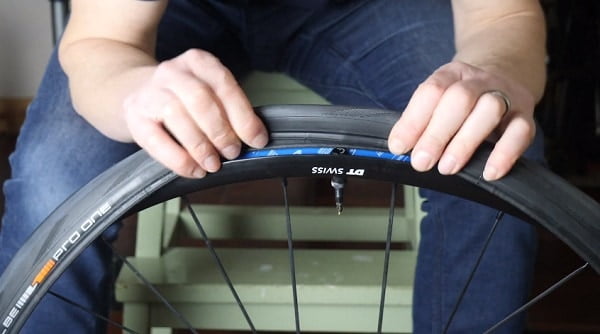
Bigger punctures are troublesome
While the sealant can take care of small punctures, it can’t handle large holes or gashes. When that happens you can’t just put in a spare tube, or can you? Turns out that you can temporarily mount an inner tube just until you get home and fix the tire. However, removing and reattaching a tubeless tire is a tough task as stated earlier. Also, by carrying spare tubes, you are pretty much losing the weight advantage that you had.
Can get messy
Remember that a liquid sealant is poured on the inside of the tire. If this is not done properly, it can get really messy. You don’t want smelly, sticky white gunk all over the place. In the case of a large enough puncture, the sealant can start spraying on you and your frame. Although rare, something called ‘burping’ can also occur. This is when your tire experiences a strong impact and the bead comes off the rim for a bit causing air and sealant to leak out.
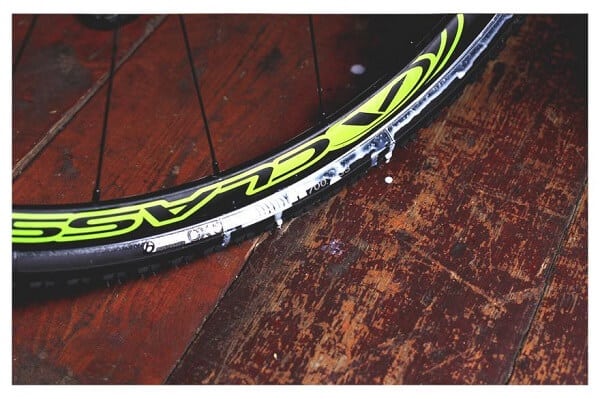
Expensive
Tubeless tires cost more than clinchers since the components need to be better designed and are harder to produce. You will also need to refill the tire with sealant from time to time. However, as the popularity of tubeless tires grow, their prices are going down day by day.
Sealant coagulates over time
Even though the sealan is so useful, one problem is that eventually it does not remain a liquid anymore. It dries up and the particles coagulate. It takes at least a few months to happen. But if you forget to replace the sealant, you could be dealing with a clogged up air valve or tires that are stuck to the rim. These things are not the end of your tires, but they are quite difficult to fix. Make sure to follow the manufacturer guidelines about when to use new sealant.
Tubeless tires for mountain biking
Unless you’ve been living under a rock, you know that tubeless tires have become the standard for mountain bikes. Mountain biking involves all kinds of rough terrain including muddy and loose conditions. Therefore, it is important to maximize traction, resistance to flats, and shock absorption. All these properties can be found in tubeless tires thanks to the absence of a tube, the presence of sealant, and the ability to run lower pressures. Because of these reasons, tubeless tires are also quite common in gravel and cyclocross bikes. In conclusion, tubeless tires are the clear winner for any form of off-road biking.
Tubeless tires for road biking
Road cycling, time trials, and triathlon bikes have very different requirements than mountain biking. These bikes need to be fast. Hence, the tires should be fast rolling and aerodynamic. Both clinchers and tubeless tires for road bikes can be equally good in terms of these parameters. However, clinchers are still more widely used due to their simplicity and ease of use.
Another reason is that manufacturers have been slow to adopt tubeless tires. This meant that there were few products for road bikes and no standards which made installation even more difficult. Tubeless road tires were also more expensive. The good news is that these problems are disappearing as tubeless is growing in popularity. If you like to take the occasional detour off the road, then tubeless is the better choice. Otherwise, there is no need to change your good old clinchers.
Frequently Asked Questions
Q1. How do you install a tubeless tire?
Ans.: As we have mentioned, tubeless tires can be difficult to install. Often there will be some issue with the fitting and you might have to troubleshoot to find out the problem. Some of the items you will need are tire levers, sealant, soapy water, valve core remover, rim tape, etc. The following video provides you with a step-by-step guide to successfully installing a tubeless tire.
Q2. What about tubular tires?
Ans.: Tubular tires feature an inner tube just like a clincher. However, the tire is sewn shut around the tube and there are no beads. Instead, the tire is attached to the rim using glue or sometimes double-sided tape. As you can guess, this makes the installation or replacement of the tire a difficult and time-consuming process. The reason why anyone would use them is due to their low weight, flat resistance, and high level of performance on the road compared to clinchers and tubeless tires. This is why tubulars are used mostly by professional racers. Another reason is that the pros usually have other people to do the tire work for them.
Q3. Why do tubeless tires need rim tape?
Ans.: The main purpose of rim tape is to help with providing an airtight seal. Not all rims are for tubeless only. Most are in fact tubeless-ready, meaning both tube and tubeless setups can be run. These rims will have spoke holes and the rim tape covers them up. It will also seal up any other opening in the rim so that air does not slowly leak out. You will have to poke a hole into the tape for the air valve. Also, without sealant, the setup will not be completely airtight.
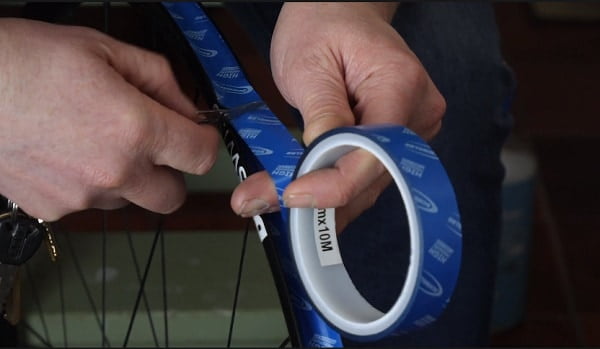
Conclusion
Tubeless tires definitely have their upsides but they also have some downsides. This means they are not inherently better than inner tube tires. It will depend on your riding style and also your personal preferences. We would suggest using tubeless tires for mountain biking, gravel riding, and cyclocross racing. For road use, you can go with either option.

I think they are not worth the cost & frustration. It has taken hours to get them seated and holding any pressure. They do not work without the sealant at all. When I tried to increase the pressure closer to the proper inflation recommendation on the tire it blew off the rim like a gunshot. I wish I had never bought them. I will install tubes inside them and forget the idea for now. To emphasize I can see no advantages in tubeless tires!!!